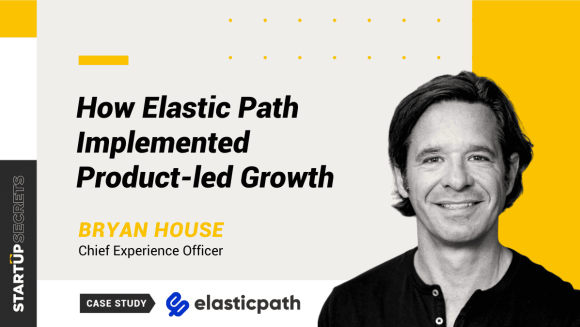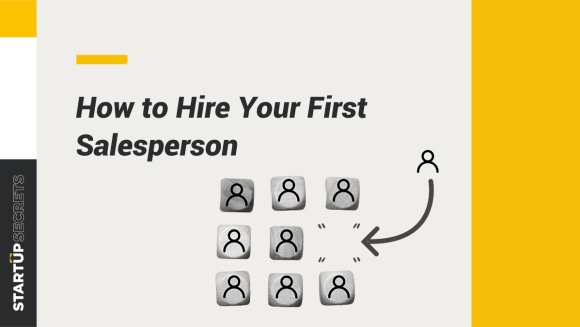In this video workshop, we dive into different strategies to get your product or service to market. It is critical for this lecture to be reviewed in conjunction with your business model. For example, it’s vital to work through the ultimate Customer Acquisition and Retention Cost (CARC) and Life Cycle Value (LCV) to develop a strategy for going to market that is consistent and profitable.
In the second video of this session, you’ll learn the tactical components for a great go-to-market plan. In particular, we’ll cover the critical elements of a marketing and sales cycle. Learn the basics of inbound marketing, outbound marketing, sales funnel design, and optimization, and lastly, the importance of customer engagement and validation.
Go-to-Market Strategies
On the go? Listen to the workshop below or subscribe on your favorite podcasting app:
How Small Companies Can Get Big – Fast!
Contributed by Michael Skok
How do small companies get big? It’s a question that gets asked a lot. It’s also a hard one to answer. Great execution is always key, but if I were to share a growth hack to multiplying that execution it would be to figure out strategic partnerships with companies larger than your own. To borrow a phrase from Isaac Newton:
“If you can learn to stand on the shoulders of giants, you can get bigger, faster.”
As a small company, you often need to zero in on a narrow product (MVP) or just as importantly a matching target market so you can achieve good product-market fit and sell repeatably into a minimum viable segment.

As a result of this focus, your product or service may be quite valuable to customers but one thing you can’t often provide from the get-go is a true end-to-end solution. If you sell a piece of software, for example, it’s unlikely you can also offer the hardware, implementation, and services as well. You’re just not big enough yet to do it all.
By engaging a larger company in a “Whole Product Strategic Partnership,” however, where you complete a bigger company’s value chain by integrating your company’s offering into their solution, you can create a win-win scenario where you both go-to-market together.
Consider the example of Unidesk, a virtual desktop management provider based outside Boston. Unidesk has put its growth on the fast-track in part because of a partnership with Dell. But why would Dell, a very large company by any measure, team up with Unidesk, a rapidly growing startup? Because for every dollar in revenue Unidesk earns on a sale, Dell earns $10. That’s quite a multiple – and it hasn’t gone unnoticed. In fact, with that much to gain, Dell has begun to send referrals to Unidesk, one in three of which typically turn into customers for Unidesk.
As a result, Dell and its sales and marketing department play a role in essentially pre-screening sales leads for Unidesk, because they know that when Unidesk closes a deal, Dell is going to sell a lot of their product. That’s a great way to build a go-to-market partnership around product integration.
And it’s precisely how small companies can get big, fast.
The Benefits of Partnering
It might, at first, seem counterintuitive that innovative and disruptive small companies stand to benefit from partnering with larger but oftentimes slower-moving firms. Aren’t they the kinds of competitors they’re trying to take down? While that can be true, small firms can also stand to gain through such partnerships for reasons that include:
- Increased revenue as a result of being able to offer customers a fuller and more complete solution. Potentially one that incorporates best-of-breed elements as well.
- Expanded reach and market share resulting from access to the larger company’s sales force and channels.
- A boost in credibility. As a small company, it can often be difficult to stand out in a crowded market or to get your calls returned. If you’re working with a firm with an established brand, on the other hand, it tends to grease the wheels.
- Faster time-to-market and reduced development costs. Imagine the amount of time and money a small firm would need to invest in order to develop an international whole product and sales campaign, for instance? It might take years. But your firm could be selling globally tomorrow via a single strategic partnership.
Assessing the Right Partner
Given what can be gained – how should smaller firms look to determine who the right kind of big company partner might be? They should begin by asking questions like:
- What are the elements of the complete solution or “whole product” that involve other larger companies?
- Which of these companies do they complement in such a way where they, like Unidesk and Dell, create mutually beneficial win-win scenarios for each other?
- Specifically which areas are complementary such as product, distribution, or market positioning that leads to a sum greater than its parts; i.e. where 1 + 1 = 3?
- Which potential partner would help drive both increased market share while also helping knock mutual competitors out of the market simultaneously?
The devil is in the details of the deal, as you don’t want to build unnatural partnerships or dangerous dependencies. So here are a few examples of things to consider:
- Will the partnership justify and tie the incentives of the larger company’s sales force to selling the smaller firm’s products/services.
- Do you have upselling opportunities?
- How can you ensure you get help with Support but don’t get isolated from your end customers?
- How will you protect your brand while the larger partner provides the credibility to help you close deals?
What’s in it for Them?
One mistake small companies make when they get the chance to approach a larger company is that they make the conversation about them, the little guy. They begin by asking how the large company can help them sell their product or service when it should be the other way around. The best way to make a partnership pitch is by approaching a company and telling them what you’re going to do for them.
So flip all the points above and ask yourself how you’ll pitch to your potential partner to ensure this is a must-have partnership for them.
Usually, one of the key benefits a large company will want to realize is the competitive advantage from faster time-to-market and more nimble development. Start there and figure out how you can build out things like opportunities to increase average revenue per user or ARPU for them. But be prepared to prove it and don’t rush it. Like any relationship, it needs to be two-way.
Bottom Line
Partner for mutual success and you’ll be able to multiply your resources with a strategic partner’s involvement. Find a way to execute on it that is a self-reinforcing win-win and it will accelerate your growth. Happy partnering!
This article originally appeared in Forbes.
Services as a Competitive Advantage: 7 Golden Nuggets and 7 Deadly Sins
Contributed by Michael Skok
One of the most controversial subjects I hear raised between entrepreneurs and investors is the use of Professional Services in a product company. Why?
Because both sides of the argument are right for why you should or should not consider the use of Professional Services (PS) in your Go To Market (GTM) Strategy. But there’s no reason to be afraid of employing a services model in your startup. If you can be informed, you can be empowered to put them to use to your competitive advantage.
So here are my 7 golden nuggets and 7 deadly sins to share learnings from my principally B2B software companies, and I welcome other’s experience and feedback.
7 Golden Nuggets
1. Pre-Sales Facilitation
- Services people are a non-threatening (non-sales) means to educate your customers on your solution.
- Professional services and even telephone support services can, therefore, accelerate your potential customer’s understanding in that part of the sales cycle. See diagram
2. Post-Sales Implementation & Support
- After you’ve closed the deal it’s critical to ensure early and continuous referenceable customer success
- So you don’t get hooked on a services model, PS can enable knowledge transfer to your customers and ultimately make them self sustaining and self-servicing
3. Customer Breadth of Deployment & Growth
- PS can enable and ensure your customer continue to get repeat success and scale of initial deployment,
- In the end, this increases the customers’ Life Cycle Value (LCV)
4. Predictable Revenue and Contribution
- PS is usually billed over a project lifetime, in a pre-agreed fashion, providing startups with some predictable revenue during otherwise unpredictable early sales cycles
- PS revenue is a welcome contribution to the Cost of Acquiring and Retaining a Customer (CARC)
5. Free Product Management
- One of my favorite value adds of PS is the direct feedback to R&D on product experience
(My personal recommendation is actually to even consider rotating engineers through services so they get the direct feedback on the implementation and usability of the products they are developing. It can be very empowering all around and customers and engineers love it if handled correctly)
6. Best Practices Buildup
- PS is one of the best ways to build up your internal best practices and knowledge base for training of new hires, as well as for external training of Developers, Customers & Partners. Per the point above this can be ultimately used to achieve self-service for your stakeholders
7. Upgrade Acceptance, Deployment
- With non-SaaS/Subscription products it’s vital to get customers to upgrade the latest releases and deploy them across the enterprise. It not only helps them but it reduces your support matrix and also justifies maintenance payments. And even if you have a SaaS model, ensuring your customers learn to use upgrades and new features is vital to them staying productive and you being competitive in their referencing in the market.
- This again increases and extends the usage and Life Cycle Value for you and your customers
That all sounds good, but there are also 7 deadly sins that I think can be argued against Professional Services.
7 Deadly Sins
1. Wrath
- Customers get angry, thinking your product should work without services
2. Greed
- You start gouging customers for extra revenue
3. Sloth
- You get lazy in fixing product issues in the product versus covering them up with PS
4. Pride
- You become so proud of the revenue PS is adding to your top line, that you forget to pay attention to your business model which may be dragged down by lower PS margins and higher fixed people costs, with lower multipliers
5. Lust
- You Lust after acquiring more customers instead of partners. Ultimately partners that can take services on for you are a much more scalable way to grow your business. But you need to time this. If you haven’t learned the experience directly, you aren’t ready to have a partner take it on.
6. Envy
- Envy between sales and services builds divided loyalty. Be careful to find a way to present an integrated sales and services front to customers to enable their success, and set up appropriate motivations and rewards for your teams to share in that customer success.
7. Gluttony
- You get hooked on a services model. This is a real risk that I’ve seen from startups who get too used to the predictable services revenues. But remember point 4, put your pride behind you and balance your business model.
In the end, my experience has been that as a startup, your initial customer success and reference ability is so critical, that developing a services-supported model can be a great approach for many initial go-to-market models, so long as you take heed of the principles I’ve outlined above.
So don’t be afraid of services, be aware of them and look to use them to your competitive advantage.
Brand Fundamentals for Startups
[arve url=”https://www.youtube.com/watch?v=WZ8G88c3e8w&feature=youtu.be” /]
As a startup, Branding is all about YOU, the founders and what you have as a vision and want to make as a brand promise.
Startup Secret: Start how you mean to end.
That is to say, think from the outset of your startup what you want to be recognized for and imagine what you want your legacy to be. This is vital because Brand needs to be consistent to be effective and though it will undoubtedly evolve, it’s tough to change.
As an example, we talk about Apple whose brand and even icon has barely evolved in 35 years since Mike Markulla defined it with Apple in Jan 1977. In the video above we talk about Apple’s brand and products “imputing value.” Also in this short segment from the full Go-to-Market session, we discuss what the key elements of your brand are and how to think about them. We cover brands as varied as Apple, Nike, Nordstrom, Puma, and Zipcar and what they stand for. And Students give their view as to why Dell, Coke, and Moleskin stand out for them.
Case Study: Unidesk and Guerilla Marketing
Startups invariably have very few resources for early marketing, and it takes creative “guerilla-style” marketing to be effective, as highlighted by this case example from Tom Rose, VP Marketing of Unidesk, and featuring the founder Chris Midgley.
Case Study: Unidesk and Distribution Channels
In this section we cover one of the key multipliers in a GTM strategy – distribution channels – brought to life by Brian McDonough of Unidesk.
Case Study: PatientPing
Jay Desai, Founder and CEO of PatientPing, describes their value proposition and how they are targeting their market.









